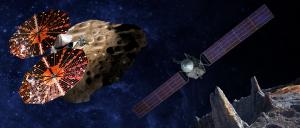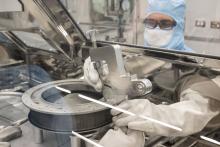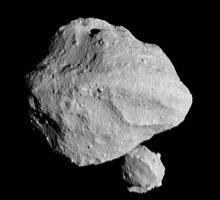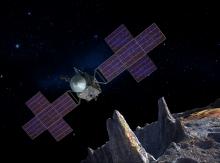Two new NASA missions will take a look at relics from the birth of the solar system. Lucy (left) will explore six Trojan asteroids, which share the orbit of Jupiter, while Psyche (right) will orbit the metallic asteroid 16 Psyche, which could be the battered core of a would-be planet that never formed. Both missions are scheduled for launch in the next decade. [SWRI/SSL/Peter Rubin]
You are here
Time Machine
Two new NASA missions are solar-system time machines. They’ll visit relics from the early solar system, providing a glimpse into the materials and processes that gave birth to the planets.
Lucy will fly past seven asteroids — big chunks of rock, metal, and ice. One of them is in the asteroid belt, between the orbits of Earth and Mars. But the others share the orbit of Jupiter. Known as Trojans, they’re locked in place ahead of or behind the giant planet by the gravity of Jupiter and the Sun.
Jupiter itself probably moved around a bit when it was young. It slid much closer to the Sun, then back out again. The Trojans might have formed with Jupiter and followed its migrations. On the other hand, they might have been captured by Jupiter as it moved. Studying them may help explain when and where they formed.
In addition, the asteroids contain materials from the birth of the solar system. They probably haven’t changed much over the eons, so they preserve a record of conditions when the solar system was young.
The mission will take advantage of existing technologies. Two of its instruments will be based on those used on New Horizons, which flew past Pluto. And a third will be based on another asteroid mission, Osiris-Rex.
Lucy will launch in 2021, with arrival at Jupiter’s orbit six years later. By then, the second mission should be well on the way to its destination — the possible core of a would-be planet. More about that tomorrow.
Script by Damond Benningfield
Get Premium Audio
Listen to today's episode of StarDate on the web the same day it airs in high-quality streaming audio without any extra ads or announcements. Choose a $8 one-month pass, or listen every day for a year for just $30.







